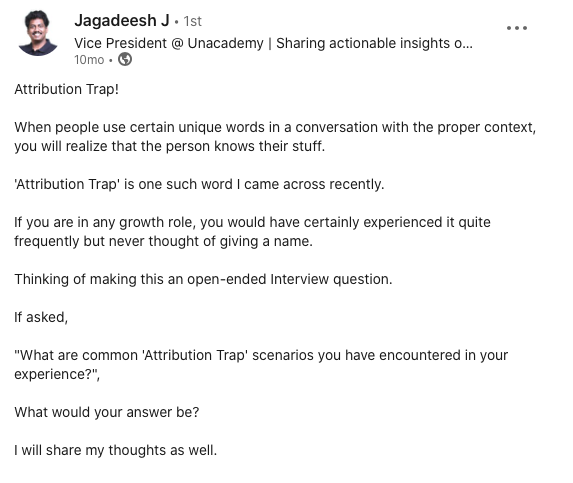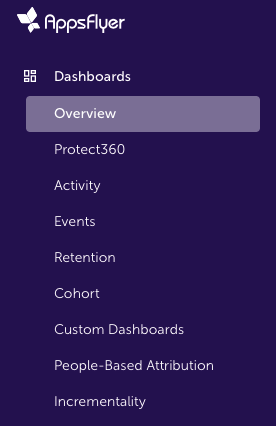By Vibha Singh | Director – APAC
This content has been inspired from the work of Jagadeesh J, VP – Digital Marketing & Growth, Unacademy


Table of Contents
What is an attribution trap?
With help of attribution, a digital marketer understands to assign the credit of the conversions to the right source/s. However, with minimal knowledge of nuances of attribution, there are several common scenarios which pose a falsified picture of attribution which confuses a digital marketer and lead to wrong decisions while planning to scale the right source/s of conversions.
All such scenarios can be classified under Attribution Trap leading to burning money on wrong ad-platforms and campaigns, if not realized in time.
The two most common scenarios of attribution traps are:
- Over or under reporting of conversions
- Delay in reporting conversions
Common Attribution Traps
In this article, we have tried to summarize very common attribution traps which any digital marketer faces in day to day life. While getting into the details of it, it’s important to understand that no attribution model is completely right or wrong for your business; however while following any attribution model, you need to understand its strengths and limitations. Most of these attribution traps happen because of limited knowledge of marketers rather than the flaws in the attribution model.
Also, the basics of attribution needs to be understood well to get what attribution is, different types of attribution and a few other related concepts which will help you to have a better context while understanding the nuances of each Attribution Trap.
2+2 = 5 : Why do you always see more conversions in ad-panels than Google analytics
The most common attribution trap happens when Google and/or Meta conversions don’t match with Google Analytics conversions and mostly higher than what Google Analytics shows.
The client who optimizes their campaigns based on the numbers shown on panel can read a wrong channel contributing to their growth and thus invest money which doesn’t give any incrementality to the business.
A few reasons because of which this trap happens:
| CAUSE | REMEDY |
| While Google & Meta Ads rely on the last click made within Google Ads, Google Analytics 4 (GA4) uses a cross channel data driven attribution model by default | Live with it |
| Meta counts View through conversions as well on its ad-panel which is not the case for Google Analytics when attributing conversions | Be cognizant of it while looking at Meta panel Vs. GA4 conversions. Also, Experiment between “7-day click” Vs. “7-day click or 1 day view” attribution setting to see if the performance changes |
| Lookback (Conversion) window in Google ad-panel not matching with lookback window in GA4 | Align the Lookback (Conversion) window for all conversions in Google Ad-panel Vs. Google Analytics. Moreover, the conversion window for both panel and analytics should be aligned with the business conversion window. |
| By default setting of the attribution window in Meta is 7 day click or 1 day view however GA4 default attribution window is 3 months | Be cognizant of it while looking at Meta panel Vs. GA4 conversions. If possible, align it with business goals on GA4. |
Table 1: Cause Vs. Remedy for the data mismatch between ad-panels and Google Analytics
Pro Tip: If you are advertising across multiple channels, it’s always advisable to shift your SoT to GA4 to have a unified view of your spend with a cognizance to the difference it will have with ad-panel while attributing conversions.
Though a disparity of close to 20% is well understood between ad-panels and Google Analytics, however anything more than this should raise a red flag for the marketer and conversion event integration to be checked thoroughly. Also at the same time, GA should not have more than 10-15% data disparity with the backend numbers for any conversion action.
Late is better than never
Have you ever observed your CAC being highly inflated when you look at your campaigns’ performance the next day however when given a week or two, it starts settling down and comes under the range?
Here comes the Late attribution trap mostly happening in case of almost all major ad-platforms because of the conversion lag between the ad-click and final purchase. As it takes a little time for someone to interact and finally purchase, the ad-panels assign it to the day the click happened even if the purchase happens with a lag (till the date of conversion is within the attribution window defined on ad-panel).
The same trap also gets visible while looking at MMPs such as Appsflyer and following data from the Overview tab which works on LTV attribution.
If stuck in this trap, the advertisers might get impatient with certain platforms and descale them without waiting enough for all the conversions happening with a lag. The trap becomes seven more dangerous for high involvement categories where Click to Purchase journey is long.
Pro tip: Collect your data for D+1, D+7, D+14, D+21 days (and more if needed) till you see no more substantial increase in conversions i.e. 75-90% of the conversions are covered. Keep it as your window after which you will take any campaign optimization call.
Closure > Discovery Trap: What to prioritize between discovery and closure over the brand
The most talked about but least solved Attribution Trap where the credit to the sources which are getting you conversion (Based on Last Click) is higher than discoverability of the brand (Based on First Click).
| Campaign | Spends | Conversions (as per last click) | CAC (Last Click) | Conversions (As per first click) | CAC (First Click) |
| Campaign 1 | 10000/- | 500 | 20/- | 2000 | 5/- |
| Campaign 2 | 10000/- | 1200 | 8/- | 1000 | 10/- |
Table 2: Comparison between two campaigns’ performance based on Last Click Vs. First Click
A normal advertiser relying on an Analytics tool working on “Last Click” attribution will keep on scaling campaign 2 while ignoring how campaign 1 is helping the brand to be discovered by new people.
While being trapped, a campaign running for top funnel objectives (such as awareness/traffic/views), which is not able to show any conversions on last click, eventually gets descaled.
Also, in performance marketing, where both prospecting and remarketing campaigns are run for bottom funnel conversions (e.g. Broad Vs. Website Visitor audiences running for Purchase optimisation), prospecting campaigns take a budget hit against re-marketing campaigns while both being judged on Last Click attribution.
Pro Tip: When you start looking at First Click along Last Click, it gives you a certain outlier over a period of time to identify the sources which are helping to discover your brand and not necessarily bringing closure immediately and gives you confidence to put more effort and money behind those sources.
Fixated App funnels: Which audience funnel to scale to increase ROI?
When App advertisers run Prospecting and Remarketing (For installers who have not purchased yet) funnels together, MMPs such as AppsFlyer throw a huge difference between ad-panel and AppsFlyer at funnel level while at aggregate level the data discrepancy isn’t that high.

Image 1: AppsFlyer Dashboards options
The remarketing funnels look extremely expensive while compared to Prospecting campaigns as per AppsFlyer Overview tab reporting which doesn’t align with marketing fundamentals (Remarketing campaigns should be cheaper than Prospecting campaigns)

Image 2: Overview tab reporting in AppsFlyer
Taking an example of a FinTech app client where loan dispersal was the campaigns’ key KPI to optimise for, we observed a huge discrepancy between the Loan Dispersed reported by Meta ad-panel Vs. AppsFlyer Overview tab for remarketing audience i.e. Users who installed the app however not yet loan disbursed . As per AppsFlyer, there were very few Loan Disbursed conversions against remarketing audiences. It made Remarketing audiences’ Cost Per Loan Disbursal (CPLD) 5X costlier than even prospecting audiences at 1/10th of the budget.

Table 3: Prospecting Vs. Remarketing campaigns’ data from AppsFlyer overview tab
To understand this, we need to understand how the overview tab attribution works. It works on LTV model and assigns the conversion to the source from where the install came pertaining to which if Remarketing campaigns are even working, their attribution is assigned to Prospecting campaigns. If observed over a period of time, we can notice Prospecting campaigns getting cheaper because of attribution coming from Remarketing campaigns.
There are more such similar scenarios of data discrepancy arising in case of different MMPs depending upon the attribution logic being followed which can be confirmed with your respective MMP team.
Pro Tip: As the App Ecosystem is yet not as evolved as web and the journey breaks at App Store (unlike web), one solution fits for all won’t work. It’s highly advisable to understand the attribution model followed by your respective MMP for different views created for data.
Also, as an alternative, use MMPs to extract raw user level data on various interactions with our ad campaigns, and then use that data to build your own attribution model as a separate source of truth to get an unbiased view without much dependency on the attribution models followed by MMPs which sometimes are over-sophisticated.
View it, Buy it: View through action Vs. Click through action
Think of a scenario where a user sees your ad but doesn’t click on it, but he remembers it and later organically searches for your brand and buys your product.
All major ad-platforms such as Meta, Google, Tik-Tok etc. take into account the conversions happening via the above scenario and assign it to respective ads. For the video inventories heavily relying on creating the impact via views (Such as YouTube, TikTok or Instagram Reels), this becomes even more crucial. That’s the reason the default attribution setting for Meta attribution is 7-day click or 1 day view.
In this scenario, when advertisers compare the conversion numbers appearing on panel (Other than Google ads) versus GA4, it throws a major discrepancy as Google Analytics works on Click Through Attribution (CTA) for all other advertising platforms than Google. Advertisers trapped in this trap are not able to understand the escalated conversions showing on ad-panels.
In case of YouTube, GA4’s DDA attribution model takes into account YouTube’s Engaged Views (30 sec or until the end it is shorter than 30 sec)
Ignoring View Through Conversions is not a solution, however here is what advertisers can do to handle this trap:
- If considering view through conversion, the attribution window should be defined relatively shorter than Click Through. So e.g. for a delivery app while the click through attribution window for install can be 7 days, it has to be 1 day for view through attribution to simply limit the days till when the impact of viewing of the ad will remain as clicking always is a more intended action than viewing. The attribution window setting can be set for any conversion action in Google Ad-Panel or in MMPs while setting up a new conversion action.
- For Meta, advertisers can experiment between “7-days click or 1 day view” Vs. “7 days click” attribution setting and see if the campaign performance gets better with different data signals to decide optimising for view through conversions or not.
Summary :
A digital marketer, while analyzing the data, sometimes gets into above mentioned or more such attribution traps without even realizing the damage it causes to optimisation and scaling of digital campaigns. It needs a thorough understanding of the attribution models and logic followed by each ad-panel and analytics platform to arrive at correct conclusions.
Though it’s important to be sensitive about these traps. However, in most of the scenarios, a digital marketer has to live with them as they mostly arise because of the custom approach taken by every platform while attributing conversions.
However, when a brand scales and invests in several channels (Online Vs. Offline), devices (Desktop, Mobile, Connected TV etc.), platforms (Google, Meta, Tik-Tok, OTTs etc.) and funnels (Prospecting Vs. Remarketing) for different objectives (Awareness Vs. Conversion), the magnitude and shape of Attribution traps change drastically deterring brand’s sustainable business growth.
In the next article of this series, we shall be covering these complex scenarios of attribution traps and how a digital marketer can handle them.
Subscribe to our newsletter for more such content or fill the best rated ad-strategy session request to uncover the growth opportunities for your account.



